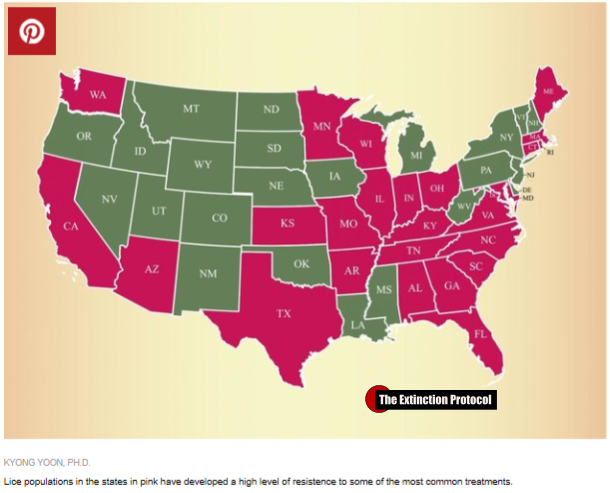skip to main |
skip to sidebar
Superbugs: treatment-resistant head lice have now spread to 25 U.S. states

August 2015 – HEALTH – Just
in time for the new school year, head lice have become literal
superbugs. Lice have developed a high level of resistance to the most
common over-the-counter treatments in 25 states, according to research
presented at a meeting of the American Chemical Society. “If you overuse
a product, over time, the selection pressure will cause insects to
develop resistance to it,” Kyong Yoon, an assistant professor of
biological and environmental science at Southern Illinois
University-Edwardsville and lead author of this ongoing research, told a
group of journalists.
Head lice are most commonly treated
with pyrethroids, a widely used class of indoor-outdoor insecticides,
often used for mosquito control. Yoon and his team found that lice
developed a gene mutation, known as knock-down resistance (kdr) against
the pyrethroids — rendering them ineffective. In 104 out of the 109 lice
populations Yoon tested, the insects were resistant to pyrethroids.
“Lice don’t have wings, and they don’t jump, so they move where people
move,” Yoon said. That’s why the new school year is such a vulnerable
time for head lice transmission. Kids bring lice back from vacations and
into the classroom, where they pass the infestation on to their
classmates.
“It’s a really, really serious problem
right now in the U.S.,” Yoon told Time. “Though head lice aren’t known
to transmit any diseases, they can be an itchy nuisance — and now,
they’re harder to kill.” Pyrethroid-resistant lice were first discovered
in Israel in the 1990s and Yoon was one of the first researchers to
report on pyrethroid-resistant lice in the United States, in
Massachusetts in 2000. “At this particular time, we have five states
that are not completely saturated with the kdr mutations,” said
co-author, J. Marshall Clark, a professor of veterinary and animal
sciences at the University of Massachusetts. Among those five states,
there’s only one state — Michigan — where the population of lice are
still largely susceptible to pyrethroids.
There are other chemicals, such
asivermectin or spinosad, which are available by prescription, that can
kill head lice, but they’re not as safe or as gentle as the pyrethroids
that doctors and schools currently recommend. “For the past 20 to 25
years, we only used the products containing over-the-counter
pyrethroids,” Clark said. “One, because they were very available. Two,
because they are incredibly safe.” To prevent head lice from mutating
again the future, said Clark, there need to be a number of anti-lice
products on the market at the same time, so that lice can’t select
against one particular mutation, the way they did with pyrethroids. –Huffington Post








0 comments:
Post a Comment